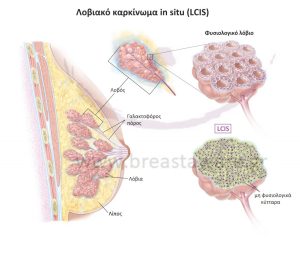Lobular Carcinoma In Situ (LCIS): Everything You Need to Know
What is Lobular Carcinoma In Situ (LCIS)?
The Lobular Carcinoma In Situ (LCIS) is an alteration found in breast lobule – the areas where milk is produced. It is characterized by increased cell proliferation, which increases the risk of breast cancer up to ten times higher than the general population.
Although it includes the term "carcinoma", LCIS not considered a true cancer, but increased risk indicatorIt can lead to the development of malignancy anywhere in both breasts, not necessarily in the area of the original diagnosis.
The term "in situ" means that the damage remains within the lobes without extending into the surrounding tissues.
Who is affected by LCIS?
LCIS is rare and the average age of diagnosis is about 45 years, with the 80-90% of the cases to concern premenopausal women.
How does LCIS differ from Ductal Carcinoma In Situ (DCIS)?
It is important to distinguish LCIS from ductal carcinoma in situ (DCIS). DCIS concerns the milk ducts and is considered a true, incipient cancer with a different treatment.
What is the risk of developing breast cancer?
Womens with diagnosis of LCIS have:
- lifetime relative risk from 8% to 30-40%, depending on factors such as age, family history and the presence of other high-risk lesions, compared to 12.5% in the general population.
- About 20% probability within 15 years.
The development of malignancy it is usually not immediate and it can happen 10-20 years or even later after diagnosis.

How is LCIS diagnosed?
The Lobular carcinoma in situ usually does not cause symptoms and has no special imaging features. It is often discovered randomly during biopsy performed for other reasons, such as a fibroadenoma.
If suspected on mammography (e.g., due to calcifications):
- It takes place core needle biopsy under local anesthesia.
- In rare cases it is required surgical biopsy with general anesthesia.
What are the next steps after diagnosis?
If diagnosed by biopsy:
- It is often recommended supplementary surgical resection for confirmation and complete removal of the area.
- In cases of classic LCIS and with a low risk of underestimation (<3%), it can be selected careful monitoring with regular check-up.
- In cases of plural form LCIS or LCIS with necrosis, is recommended more aggressive diagnostic approach, due to a higher risk of coexisting malignancy.
Decisions are always personalized in collaboration with a specialized breast surgeon.
How can the risk of breast cancer be reduced?
For women with LCIS, there are ways risk reduction:
- Endocrine Therapy with tamoxifen, raloxifene or aromatase inhibitors can reduce the risk of developing cancer by about 50%. This choice should take into account the individual risk profile, the patient's age and possible side effects. Not recommended in all routine cases.
- In special cases, it may be recommended prophylactic bilateral mastectomy, especially in women with strong family history or mutation in the BRCA1/BRCA2 genes.
Because the Lobular carcinoma in situ is not an immediate threat and because many women will never develop cancer, each decision is made carefully and individually, after full discussion with the medical team.
Get Accurate Information at BreastAware.gr
At BreastAware.gr , you’ll find reliable, scientifically validated, and user-friendly information on all breast diseases. Our goal is to empower you with knowledge and support for your health, focusing on prevention and early diagnosis.
Bibliography:
- Baker J , Noguch N, et al. Atypical ductal or lobular hyperplasia, lobular carcinoma in-situ, flat epithelial atypia and breast cancer risk: A systematic review and meta-analysis. Cancer Epidemiol. 2024 Aug;86:102593.
- Update on Lobular Lesions of the Breast. Pathol Res Pract. 2023;237:154159.
- Harinath L, Villatoro T, et al. Upgrade Rates of Variant Lobular Carcinoma In Situ Compared to Classic Lobular Carcinoma In Situ: A Multi-Institutional Study. Mod Pathol. 2024;37(3):456–464.
- Clinical guidance for the management of lobular carcinoma in situ. Cancer Australia. 2024 Nov 13.
- Surgical Management of Benign or High-Risk Lesions: A Consensus Statement from the American Society of Breast Surgeons. ASBrS. 2024 Mar.
